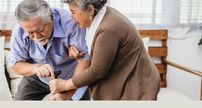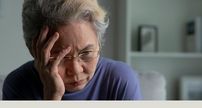
Course Listing
Advance your knowledge in engaging, interactive courses developed and taught by leaders in the field.
Browse All MDS Courses
New courses are added regularly. If there are not courses listed in the category you are searching, more will be scheduled at a later date. Check back soon or sign up for email notifications.
Diagnosis and Management of Motor Symptoms in Early Parkinson's Disease
On Demand
Interactive
60 Minutes
Foundational / Beginner
1047 <p>This module will explore the clinical diagnostic criteria for Parkinson’s Disease (PD) with emphasis on early stage motor symptoms, as well as exploring atypical presentations and potential differentials. Treatment of early PD motor symptoms will be discussed using the evidence basis for approved therapies.</p> Biomarkers, Biomarkers & Diagnostic Tools, Corticobasal Syndrome (CBS)/Corticobasal Degeneration (CBD), Etiology & Pathophysiology, Genetics, Lewy-body dementia (LBD), Medications for motor symptoms, Multiple Systems Atrophy (MSA), Neuroimaging, Neuropathology, Parkinson Disease/Hypokinetic Movement Disorders, Parkinson's Disease (PD), Progressive Supranuclear Palsy (PSP), Rating Scales, Therapies-Pharmacological 60 1.00 https://education.movementdisorders.org/Detail/1047/Diagnosis-and-Management-of-Motor-Symptoms-in-Early-Parkinson's-Disease https://education.movementdisorders.org/Upload/ActivityImages/05INTERACT-44-001--Motor-Symptoms-in-Early-PD-202x108552477.jpg https://education.movementdisorders.org/Upload/BannerImages/05INTERACT-44-001--Motor-Symptoms-in-Early-PD-734x404583314.jpg 2025-11-06T00:00:00 2028-11-06T00:00:00 <p><strong>ACCREDITATION STATEMENT</strong></p><p>This activity has been planned and implemented in accordance with the accreditation requirements and policies of the Accreditation Council for Continuing Medical Education (ACCME). The International Parkinson and Movement Disorder Society is accredited by the ACCME to provide continuing medical education for physicians.</p><p><br></p><p><strong>CREDIT DESIGNATION STATEMENT</strong></p><p>The International Parkinson and Movement Disorder Society designates this activity for a maximum of 1 <em>AMA PRA Category 1 Credits™</em>. Physicians should only claim credit commensurate with the extent of their participation.</p><p><br></p><p><strong>FACULTY DISCLOSURE</strong></p><p>All individuals in control of content for this activity are required to disclose all financial relationships with ineligible companies (as defined by the ACCME) over the last 24 months. Disclosure information is available <a class="fr-file" href="https://d1t84l7yt030ad.cloudfront.net/FroalaFiles/Disclosures - Early PD_20102025113733.pdf" target="_blank">HERE</a>. All relevant financial relationships have been mitigated in advance of this program.</p><p><br></p><p><strong>SATISFACTORY COMPLETION</strong></p><p>Participants must complete an evaluation for each session they attend to receive continuing medical education credit. Your chosen session(s) must be attended in their entirety. Partial credit for individual sessions is not available.</p><p><br></p><p><strong>METHOD OF PARTICIPATION </strong></p><p>Your chosen sessions must be attended in their entirety. Partial credit of individual sessions is not available. If you are seeking continuing education credit for a specialty not listed in the Accreditation Statement, it is your responsibility to contact your licensing/certification board to determine course eligibility for your board requirement.</p><p><br></p><p><strong>CONTENT VALIDITY STATEMENT</strong></p><p>All recommendations involving clinical medicine in MDS activities are based on evidence that is accepted within the profession of medicine as adequate justification for their indications and contraindications in the case of patients. All scientific research referred to, reported or used in CME in support or justification of a patient care recommendations conforms to the generally accepted standards of experimental design, data collection and analysis. Activities that promote recommendations, treatment or manners of practicing medicine not within the definition of CME or are knowing to have risks or dangers that outweigh the benefits or are knowing to be ineffective in the treatment of patients do not constitute valid CME.</p> MDS Education <p><strong>FACULTY</strong></p><p>Rob de Bie, MD, PhD - Amsterdam University Medical Center, Amsterdam, Netherlands</p><p>Monty Silverdale, MD, PhD - Manchester Centre for Clinical Neurosciences, Salford, United Kingdom</p><p>Ai Huey Tan, MD, PhD, FRCP - University of Malaya, Kuala Lumpur, Malaysia</p><p><br></p><p><strong>LEARNING OBJECTIVES</strong></p><p>Upon completion of this activity, learners will be able to: </p><p>1. Obtain a good clinical history from a patient presenting with parkinsonian features.</p><p>2. Identify typical and atypical features in clinical examination of a patient presenting with parkinsonian features.</p><p>3. Develop a step-by-step approach in making a diagnosis of Parkinson’s disease based on the MDS Clinical Diagnostic Criteria.</p><p>4. Outline a treatment plan for managing motor symptoms in early Parkinson’s disease based on available clinical evidence.</p><p><br></p><p><strong>INTENDED AUDIENCE</strong></p><p>This activity is intended for students, residents, primary care providers, internists, allied health, non-neurology specialists, and industry who have limited to no movement disorder experience.</p><p><br></p><p><strong>HARDWARE AND SOFTWARE REQUIREMENTS</strong></p><p>1. Active Internet connection (DSL or Cable). Dial-up connection will have constant buffering problem.</p><p>2. Compatible with Windows PC and MAC (256 MB of RAM or higher).</p><p>3. Activity is best viewed on Internet Explorer 9.0 or higher, Safari 5.0 or higher and Firefox 29.0 or higher.</p><p>4. Adobe Flash Player 12.0 (or higher).</p><p>5. Adobe Reader to print certificate.</p> 0 /Courses/Diagnosis-and-Management-of-Motor-Symptoms-in-Early-Parkinsons-Disease.htm Diagnosis and Management of Motor Symptoms in Early Parkinson's Disease 2025-11-06T15:01:05.570 0 0 Foundational / Beginner Clinician Fellow Industry Resident Student Interactive CME English On-Demand USA
A Comprehensive Approach to Autonomic Dysfunction in Parkinson's Disease
On Demand
Interactive
60 Minutes
Foundational / Beginner
1009 <p>This module will provide comprehensive and practical information regarding the definition, diagnosis and management of diverse manifestations of autonomic dysfunction in Parkinson's disease. This includes cardiovascular, gastrointestinal, urinary and sexual symptoms.</p> Autonomic Dysfunction, Complementary and Alternative Medicine, Exercise, Genetics, Medications for non-motor symptoms, Non-invasive stimulation, Non-motor Symptoms/Disorders, Nutritional Therapy, Occupational Therapy, Parkinson Disease/Hypokinetic Movement Disorders, Parkinson's Disease (PD), Physical Therapy/Physiotherapy, Psychiatry, Psychology/Psychotherapy, Sexual Health, Social Work, Speech Therapy, Therapies-Other, Therapies-Pharmacological 60 1.00 https://education.movementdisorders.org/Detail/1009/A-Comprehensive-Approach-to-Autonomic-Dysfunction-in-Parkinson's-Disease https://education.movementdisorders.org/Upload/ActivityImages/05INTERACT-42-001--Autonomic-Dysfunction-in-PD--202x108474917.jpg https://education.movementdisorders.org/Upload/BannerImages/05INTERACT-42-001--Autonomic-Dysfunction-in-PD-734x404929176.jpg 2025-07-16T00:00:00 2028-07-16T00:00:00 <p><strong>ACCREDITATION STATEMENT</strong></p><p>This activity has been planned and implemented in accordance with the accreditation requirements and policies of the Accreditation Council for Continuing Medical Education (ACCME). The International Parkinson and Movement Disorder Society is accredited by the ACCME to provide continuing medical education for physicians.</p><p><br></p><p><strong>CREDIT DESIGNATION STATEMENT</strong></p><p>The International Parkinson and Movement Disorder Society designates this activity for a maximum of 1 <em>AMA PRA Category 1 Credits™</em>. Physicians should only claim credit commensurate with the extent of their participation.</p><p><br></p><p><strong>FACULTY DISCLOSURE</strong></p><p>All individuals in control of content for this activity are required to disclose all financial relationships with ineligible companies (as defined by the ACCME) over the last 24 months. Disclosure information is available <a class="fr-file" href="https://d1t84l7yt030ad.cloudfront.net/FroalaFiles/Autonomic Dysfunction in PD - Disclosures_08072025015142.pdf" target="_blank">HERE</a>. All relevant financial relationships have been mitigated in advance of this program.</p><p><br></p><p><strong>SATISFACTORY COMPLETION</strong></p><p>Participants must complete an evaluation for each session they attend to receive continuing medical education credit. Your chosen session(s) must be attended in their entirety. Partial credit for individual sessions is not available.</p><p><br></p><p><strong>METHOD OF PARTICIPATION </strong></p><p>Your chosen sessions must be attended in their entirety. Partial credit of individual sessions is not available. If you are seeking continuing education credit for a specialty not listed in the Accreditation Statement, it is your responsibility to contact your licensing/certification board to determine course eligibility for your board requirement.</p><p><br></p><p><strong>CONTENT VALIDITY STATEMENT</strong></p><p>All recommendations involving clinical medicine in MDS activities are based on evidence that is accepted within the profession of medicine as adequate justification for their indications and contraindications in the case of patients. All scientific research referred to, reported or used in CME in support or justification of a patient care recommendations conforms to the generally accepted standards of experimental design, data collection and analysis. Activities that promote recommendations, treatment or manners of practicing medicine not within the definition of CME or are knowing to have risks or dangers that outweigh the benefits or are knowing to be ineffective in the treatment of patients do not constitute valid CME.</p> MDS Education <p><span style="background-color: null;"><strong>FACULTY</strong></span></p><p>Veronica Bruno, MD, MPH - University of Calgary, Calgary, Canada</p><p>Santiago Perez-Lloret, MD, PhD - National Scientific and Technic Research Council, Buenos Aires, Argentina</p><p><br></p><p><strong>LEARNING OBJECTIVES</strong></p><p>Upon completion of this activity, learners will be able to: </p><p>1. List the autonomic dysfunction symptoms affecting PD patients.</p><p>2. Analyze the prevalence, physiopathology and impact of autonomic dysfunction in PD</p><p>3. Outline a practical approach to diagnose the different manifestations of autonomic dysfunction in PD.</p><p>4. Discuss management of autonomic dysfunction in PD.</p><p><br></p><p><strong>INTENDED AUDIENCE</strong></p><p>This activity is intended for students, residents, primary care providers, internists, allied health, non-neurology specialists, and industry who have limited to no movement disorder experience.</p><p><br></p><p><strong>HARDWARE AND SOFTWARE REQUIREMENTS</strong></p><p>1. Active Internet connection (DSL or Cable). Dial-up connection will have constant buffering problem.</p><p>2. Compatible with Windows PC and MAC (256 MB of RAM or higher).</p><p>3. Activity is best viewed on Internet Explorer 9.0 or higher, Safari 5.0 or higher and Firefox 29.0 or higher.</p><p>4. Adobe Flash Player 12.0 (or higher).</p><p>5. Adobe Reader to print certificate.</p> 0 /Courses/A-Comprehensive-Approach-to-Autonomic-Dysfunction-in-Parkinsons-Disease.htm A Comprehensive Approach to Autonomic Dysfunction in Parkinson's Disease 2025-07-16T15:01:03.980 0 0 Foundational / Beginner Clinician Fellow Industry Resident Student Interactive CME English On-Demand USA
Approach and Management of Neuropsychiatric Issues in Parkinson’s Disease
On Demand
Interactive
60 Minutes
Foundational / Beginner
919 This module will provide up-to-date knowledge of key neuropsychiatric features of movement disorders including practical guidelines, assessment tools for diagnosis and evidence-based treatments. Additionally, the module will discuss state-of-the-art care for the complex needs of our patients with movement disorders. Anxiety/Depression, Impulse Control Disorders, Neuropsychiatric symptoms, Non-motor Symptoms/Disorders, Parkinson Disease/Hypokinetic Movement Disorders, Parkinson's Disease (PD), Psychiatry, Psychology/Psychotherapy, Psychosis, Therapies-Other Lana Chahine, MD; Daniel Weintraub, MD; Bart Swinnen, MD, PhD 60 1.00 2025-03-17 https://education.movementdisorders.org/Detail/919/Approach-and-Management-of-Neuropsychiatric-Issues-in-Parkinson’s-Disease https://education.movementdisorders.org/Upload/ActivityImages/05INTERACT-41-001-Neuropsychiatric-Issues-in-PD-202x108893222.jpg 2025-03-17T00:00:00 2028-03-17T00:00:00 <p><strong>ACCREDITATION STATEMENT</strong></p><p>This activity has been planned and implemented in accordance with the accreditation requirements and policies of the Accreditation Council for Continuing Medical Education (ACCME). The International Parkinson and Movement Disorder Society is accredited by the ACCME to provide continuing medical education for physicians.</p><p><br></p><p><strong>CREDIT DESIGNATION STATEMENT</strong></p><p>The International Parkinson and Movement Disorder Society designates this activity for a maximum of 1 <em>AMA PRA Category 1 Credits™</em>. Physicians should only claim credit commensurate with the extent of their participation.</p><p><br></p><p><strong>FACULTY DISCLOSURE</strong></p><p>All individuals in control of content for this activity are required to disclose all financial relationships with ineligible companies (as defined by the ACCME) over the last 24 months. Disclosure information is available <a class="fr-file" href="https://d1t84l7yt030ad.cloudfront.net/FroalaFiles/Disclosures - Neuropsychiatric Issues in PD_03032025030439.pdf" target="_blank">HERE</a>. All relevant financial relationships have been mitigated in advance of this program.</p><p><br></p><p><strong>SATISFACTORY COMPLETION</strong></p><p>Participants must complete an evaluation for each session they attend to receive continuing medical education credit. Your chosen session(s) must be attended in their entirety. Partial credit for individual sessions is not available.</p><p><br></p><p><strong>METHOD OF PARTICIPATION </strong></p><p>Your chosen sessions must be attended in their entirety. Partial credit of individual sessions is not available. If you are seeking continuing education credit for a specialty not listed in the Accreditation Statement, it is your responsibility to contact your licensing/certification board to determine course eligibility for your board requirement.</p><p><br></p><p><strong>CONTENT VALIDITY STATEMENT</strong></p><p>All recommendations involving clinical medicine in MDS activities are based on evidence that is accepted within the profession of medicine as adequate justification for their indications and contraindications in the case of patients. All scientific research referred to, reported or used in CME in support or justification of a patient care recommendations conforms to the generally accepted standards of experimental design, data collection and analysis. Activities that promote recommendations, treatment or manners of practicing medicine not within the definition of CME or are knowing to have risks or dangers that outweigh the benefits or are knowing to be ineffective in the treatment of patients do not constitute valid CME.</p> MDS Education <p><span style="background-color: null;"><strong>FACULTY</strong></span></p><p>Lana Chahine, MD - University of Pittsburgh, Pittsburgh, PA, USA</p><p>Daniel Weintraub, MD - University of Pennsylvania, Philadelphia, PA, USA</p><p>Bart Swinnen, MD, PhD - UCSF, San Francisco, CA, USA</p><p><br></p><p><strong>LEARNING OBJECTIVES</strong></p><p>Upon completion of this activity, learners will be able to: </p><p>1. Recognize the range of key neuropsychiatric features of movement disorders.</p><p>2. Learn how to assess and diagnose neuropsychiatric disorders in movement disorders.</p><p>3. Implement an evidence-based treatment plan for neuropsychiatric features of movement disorders.</p><p><br></p><p><strong>INTENDED AUDIENCE</strong></p><p>This activity is intended for students, residents, primary care providers, internists, allied health, non-neurology specialists, and industry who have limited to no movement disorder experience.</p><p><br></p><p><strong>HARDWARE AND SOFTWARE REQUIREMENTS</strong></p><p>1. Active Internet connection (DSL or Cable). Dial-up connection will have constant buffering problem.</p><p>2. Compatible with Windows PC and MAC (256 MB of RAM or higher).</p><p>3. Activity is best viewed on Internet Explorer 9.0 or higher, Safari 5.0 or higher and Firefox 29.0 or higher.</p><p>4. Adobe Flash Player 12.0 (or higher).</p><p>5. Adobe Reader to print certificate.</p> 0 /Courses/Approach-and-Management-of-Neuropsychiatric-Issues-in-Parkinsons-Disease.htm Approach and Management of Neuropsychiatric Issues in Parkinson’s Disease 2025-03-17T00:01:37.670 0 0 Foundational / Beginner Clinician Fellow Industry Resident Student Interactive CME English On-Demand USA
Neuroimaging in Parkinsonian Syndromes
On Demand
Interactive
60 Minutes
Foundational / Beginner
903 This module will discuss the characteristics of each imaging technique and the imaging findings related to parkinsonian syndromes. Before starting this module, the audience is recommended to understand key clinical features of parkinsonian syndromes and their relevant pathological locations. Biomarkers & Diagnostic Tools, Etiology & Pathophysiology, Multiple Systems Atrophy (MSA), Neuroimaging, Neuropathology, Parkinson Disease/Hypokinetic Movement Disorders, Synucleinopathy Elie Matar, MD, PhD 60 1.00 2025-01-15 https://education.movementdisorders.org/Detail/903/Neuroimaging-in-Parkinsonian-Syndromes https://education.movementdisorders.org/Upload/ActivityImages/Neuroimaging-in-Parkinsonian-Syndromes151395.jpg 2025-01-15T00:00:00 2028-01-15T00:00:00 <p><strong>ACCREDITATION STATEMENT</strong></p><p>This activity has been planned and implemented in accordance with the accreditation requirements and policies of the Accreditation Council for Continuing Medical Education (ACCME). The International Parkinson and Movement Disorder Society is accredited by the ACCME to provide continuing medical education for physicians.</p><p><br></p><p><strong>CREDIT DESIGNATION STATEMENT</strong></p><p>The International Parkinson and Movement Disorder Society designates this activity for a maximum of 1 <em>AMA PRA Category 1 Credits™</em>. Physicians should only claim credit commensurate with the extent of their participation.</p><p><br></p><p><strong>FACULTY DISCLOSURE</strong></p><p>All individuals in control of content for this activity are required to disclose all financial relationships with ineligible companies (as defined by the ACCME) over the last 24 months. Disclosure information is available <a class="fr-file" href="https://s3-us-east-2.amazonaws.com/mds-lms/FroalaFiles/NIMD - Disclosures_11122024020550.pdf" target="_blank">HERE</a>. All relevant financial relationships have been mitigated in advance of this program.</p><p><br></p><p><strong>SATISFACTORY COMPLETION</strong></p><p>Participants must complete an evaluation for each session they attend to receive continuing medical education credit. Your chosen session(s) must be attended in their entirety. Partial credit for individual sessions is not available.</p><p><br></p><p><strong>METHOD OF PARTICIPATION </strong></p><p>Your chosen sessions must be attended in their entirety. Partial credit of individual sessions is not available. If you are seeking continuing education credit for a specialty not listed in the Accreditation Statement, it is your responsibility to contact your licensing/certification board to determine course eligibility for your board requirement.</p><p><br></p><p><strong>CONTENT VALIDITY STATEMENT</strong></p><p>All recommendations involving clinical medicine in MDS activities are based on evidence that is accepted within the profession of medicine as adequate justification for their indications and contraindications in the case of patients. All scientific research referred to, reported or used in CME in support or justification of a patient care recommendations conforms to the generally accepted standards of experimental design, data collection and analysis. Activities that promote recommendations, treatment or manners of practicing medicine not within the definition of CME or are knowing to have risks or dangers that outweigh the benefits or are knowing to be ineffective in the treatment of patients do not constitute valid CME.</p> MDS Education <p><span style="background-color: null;"><strong>FACULTY</strong></span></p><p>Elie Matar, MD, PhD - University of Sydney / University College London, Sydney, Australia</p><p><br></p><p><strong>LEARNING OBJECTIVES</strong></p><p>Upon completion of this activity, learners will be able to: </p><p>1. Understand the characteristics of each imaging technique.</p><p>2. Learn the conventional imaging findings specific to the common parkinsonian syndromes and mimics.</p><p>3. Develop awareness of application of additional neuroimaging modalities and analytical tools as emerging biomarkers in the field.</p><p><br></p><p><strong>INTENDED AUDIENCE</strong></p><p>This activity is intended for students, residents, primary care providers, internists, allied health, non-neurology specialists, and industry who have limited to no movement disorder experience.</p><p><br></p><p><strong>HARDWARE AND SOFTWARE REQUIREMENTS</strong></p><p>1. Active Internet connection (DSL or Cable). Dial-up connection will have constant buffering problem.</p><p>2. Compatible with Windows PC and MAC (256 MB of RAM or higher).</p><p>3. Activity is best viewed on Internet Explorer 9.0 or higher, Safari 5.0 or higher and Firefox 29.0 or higher.</p><p>4. Adobe Flash Player 12.0 (or higher).</p><p>5. Adobe Reader to print certificate.</p> 0 /Courses/Neuroimaging-in-Parkinsonian-Syndromes.htm Neuroimaging in Parkinsonian Syndromes 2025-01-15T00:01:23.033 0 0 Foundational / Beginner Clinician Fellow Industry Resident Student Interactive CME English On-Demand USA
Cell Models of Parkinson’s Disease
On Demand
Interactive
60 Minutes
Foundational / Beginner
663 The Cell Models of Parkinson's Disease module provides an introductory course on cellular models of Parkinson’s disease, their strengths and limitations, their use in experimental and pre-clinical applications and how to critically interpret findings in research and translational contexts. Animal models, Basal Ganglia, Basic/Translational Neuroscience, Genetics, Neuropathology, Parkinson Disease/Hypokinetic Movement Disorders, Parkinson's Disease (PD), Synucleinopathy, Tauopathy Tiago Outeiro, PhD 60 1.00 2024-12-09 https://education.movementdisorders.org/Detail/663/Cell-Models-of-Parkinson’s-Disease https://education.movementdisorders.org/Upload/ActivityImages/Cell-Models_202x108161054.png 2024-12-09T00:00:00 2027-12-09T00:00:00 <p><strong>ACCREDITATION STATEMENT</strong></p><p>This activity has been planned and implemented in accordance with the accreditation requirements and policies of the Accreditation Council for Continuing Medical Education (ACCME). The International Parkinson and Movement Disorder Society is accredited by the ACCME to provide continuing medical education for physicians.</p><p><br></p><p><strong>CREDIT DESIGNATION STATEMENT</strong></p><p>The International Parkinson and Movement Disorder Society designates this activity for a maximum of 1 <em>AMA PRA Category 1 Credits™</em>. Physicians should only claim credit commensurate with the extent of their participation.</p><p><br></p><p><strong>FACULTY DISCLOSURE</strong></p><p>All individuals in control of content for this activity are required to disclose all financial relationships with ineligible companies (as defined by the ACCME) over the last 24 months. Disclosure information is available <a href="https://s3-us-east-2.amazonaws.com/mds-lms/FroalaFiles/Faculty%20Disclosures%20-%20Cell%20Models%20of%20PD_21082024014214.pdf" rel="noopener noreferrer" target="_blank">HERE.</a> All relevant financial relationships have been mitigated in advance of this program.</p><p><br></p><p><strong>SATISFACTORY COMPLETION</strong></p><p>Participants must complete an evaluation for each session they attend to receive continuing medical education credit. Your chosen session(s) must be attended in their entirety. Partial credit for individual sessions is not available.</p><p><br></p><p><strong>METHOD OF PARTICIPATION </strong></p><p>Your chosen sessions must be attended in their entirety. Partial credit of individual sessions is not available. If you are seeking continuing education credit for a specialty not listed in the Accreditation Statement, it is your responsibility to contact your licensing/certification board to determine course eligibility for your board requirement.</p><p><br></p><p><strong>CONTENT VALIDITY STATEMENT</strong></p><p>All recommendations involving clinical medicine in MDS activities are based on evidence that is accepted within the profession of medicine as adequate justification for their indications and contraindications in the case of patients. All scientific research referred to, reported or used in CME in support or justification of a patient care recommendations conforms to the generally accepted standards of experimental design, data collection and analysis. Activities that promote recommendations, treatment or manners of practicing medicine not within the definition of CME or are knowing to have risks or dangers that outweigh the benefits or are knowing to be ineffective in the treatment of patients do not constitute valid CME.</p> MDS Education <p><span style="background-color: null;"><strong>FACULTY</strong></span></p><p>Tiago Outeiro, PhD - University Medical Center Goettingen, Goettingen, Germany</p><p><br></p><p><strong>LEARNING OBJECTIVES</strong></p><p>Upon completion of this activity, learners will be able to:</p><p>1. Discuss cell models of Parkinson’s disease and their pathological basis.<br>2. Define the strengths and limitations of Parkinson’s disease cell models and contextualize their extrapolability.<br>3. Outline the use of Parkinson’s disease cell models in experimental and pre-clinical settings and how to critically interpret findings.</p><p><br></p><p><strong>INTENDED AUDIENCE</strong></p><p><span data-contrast="auto" lang="EN-US">This activity is intended for students, residents, primary care providers, internists, allied health, non-neurology specialists, and industry who have limited to no movement disorder experience.</span><span data-ccp-props='{"201341983":0,"335559740":259}'> </span></p><p><br></p><p><strong>HARDWARE AND SOFTWARE REQUIREMENTS</strong></p><p>1. Active Internet connection (DSL or Cable). Dial-up connection will have constant buffering problem.</p><p>2. Compatible with Windows PC and MAC (256 MB of RAM or higher).</p><p>3. Activity is best viewed on Internet Explorer 9.0 or higher, Safari 5.0 or higher and Firefox 29.0 or higher.</p><p>4. Adobe Flash Player 12.0 (or higher).</p><p>5. Adobe Reader to print certificate.</p> 0 /Courses/Cell-Models-of-Parkinsons-Disease.htm Cell Models of Parkinson’s Disease 2024-12-09T15:00:47.957 0 0 Foundational / Beginner Clinician Clinician-Primary Care Fellow Industry Resident Student Interactive CME English On-Demand USA
Functional Movement Disorders
On Demand
Interactive
60 Minutes
Foundational / Beginner
806 This module will discuss the definition, possible aetiologic factors (neurobiology) and diagnostic criteria of functional movement disorders. The different clinical presentations, practical approach to evaluation via detailed history and exam, role of investigations and multi-disciplinary approach to management will also be discussed. Chorea/Huntingtons Disease (HD), Dystonia, Freezing of Gait (FOG), Functional Movement Disorders, Hyperkinetic Movement Disorders, Myoclonus, Other Movement Disorders, Parkinson Disease/Hypokinetic Movement Disorders, Tics/Tourettes syndrome (TS), Tremor/Essential Tremor (ET) Shilpa Chitnis, MD, PhD, Sanjay Pandey, MD, DM, Soaham Desai, MD, DM 60 1.00 2024-11-20 https://education.movementdisorders.org/Detail/806/Functional-Movement-Disorders https://education.movementdisorders.org/Upload/ActivityImages/Functional-Movement-Disorders341446.jpg 2024-11-20T00:00:00 2027-11-20T00:00:00 <p><strong>ACCREDITATION STATEMENT</strong></p><p>This activity has been planned and implemented in accordance with the accreditation requirements and policies of the Accreditation Council for Continuing Medical Education (ACCME). The International Parkinson and Movement Disorder Society is accredited by the ACCME to provide continuing medical education for physicians.</p><p><br></p><p><strong>CREDIT DESIGNATION STATEMENT</strong></p><p>The International Parkinson and Movement Disorder Society designates this activity for a maximum of 1 <em>AMA PRA Category 1 Credits™</em>. Physicians should only claim credit commensurate with the extent of their participation.</p><p><br></p><p><strong>FACULTY DISCLOSURE</strong></p><p>All individuals in control of content for this activity are required to disclose all financial relationships with ineligible companies (as defined by the ACCME) over the last 24 months. Disclosure information is available <a class="fr-file" href="https://s3-us-east-2.amazonaws.com/mds-lms/FroalaFiles/Faculty Disclosure (1)_12042024015335.pdf" target="_blank">HERE</a>. All relevant financial relationships have been mitigated in advance of this program.</p><p><br></p><p><strong>SATISFACTORY COMPLETION</strong></p><p>Participants must complete an evaluation for each session they attend to receive continuing medical education credit. Your chosen session(s) must be attended in their entirety. Partial credit for individual sessions is not available.</p><p><br></p><p><strong>METHOD OF PARTICIPATION </strong></p><p>Your chosen sessions must be attended in their entirety. Partial credit of individual sessions is not available. If you are seeking continuing education credit for a specialty not listed in the Accreditation Statement, it is your responsibility to contact your licensing/certification board to determine course eligibility for your board requirement.</p><p><br></p><p><strong>CONTENT VALIDITY STATEMENT</strong></p><p>All recommendations involving clinical medicine in MDS activities are based on evidence that is accepted within the profession of medicine as adequate justification for their indications and contraindications in the case of patients. All scientific research referred to, reported or used in CME in support or justification of a patient care recommendations conforms to the generally accepted standards of experimental design, data collection and analysis. Activities that promote recommendations, treatment or manners of practicing medicine not within the definition of CME or are knowing to have risks or dangers that outweigh the benefits or are knowing to be ineffective in the treatment of patients do not constitute valid CME.</p> MDS Education <p><span style="background-color: null;"><strong>FACULTY</strong></span></p><p>Shilpa Chitnis, MD, PhD - UT Southwestern Medical Center, Dallas, TX, USA</p><p>Sanjay Pandey, DM - Amrita Hospital, Faridabad, Delhi NCR, India</p><p>Soaham Desai, MD, DM - Shree Krishna Hospital Pramukhswami Medical College Bhaikaka University, Anand, India</p><p><br></p><p><strong>LEARNING OBJECTIVES</strong></p><p>Upon completion of this activity, learners will be able to: </p><p>1. Identify the different clinical presentations of functional movement disorders.</p><p>2. Recognize and examine for positive signs that rule-in a diagnosis of functional movement disorders.</p><p>3. Outline a practical approach to the clinical evaluation and management of functional movement disorders.</p><p><br></p><p><strong>INTENDED AUDIENCE</strong></p><p>This activity is intended for students, residents, primary care providers, internists, allied health, non-neurology specialists, and industry who have limited to no movement disorder experience.</p><p><br></p><p><strong>HARDWARE AND SOFTWARE REQUIREMENTS</strong></p><p>1. Active Internet connection (DSL or Cable). Dial-up connection will have constant buffering problem.</p><p>2. Compatible with Windows PC and MAC (256 MB of RAM or higher).</p><p>3. Activity is best viewed on Internet Explorer 9.0 or higher, Safari 5.0 or higher and Firefox 29.0 or higher.</p><p>4. Adobe Flash Player 12.0 (or higher).</p><p>5. Adobe Reader to print certificate.</p> 0 /Courses/Functional-Movement-Disorders.htm Functional Movement Disorders 2024-11-19T15:00:35.477 0 0 Foundational / Beginner Clinician Fellow Industry Resident Student Interactive CME English On-Demand USA
Multiple System Atrophy
On Demand
Interactive
60 Minutes
Foundational / Beginner
837 This module on Multiple System Atrophy (MSA) will cover the definition, epidemiology, neuropathology, pathophysiology, clinical presentation and natural history of MSA. The new MDS MSA criteria and differential diagnosis will be discussed, along with current symptomatic treatment and potential treatment targets in the development pipeline. Biomarkers, Biomarkers & Diagnostic Tools, Genetics, Multiple Systems Atrophy (MSA), Neuroimaging, Neuropathology, Parkinson Disease/Hypokinetic Movement Disorders, Rating Scales Margherita Fabbri, MD, PhD, Alessandra Fanciulli, MD, PhD, Miriam Sklerov, MD, MS 60 1.00 2024-10-22 https://education.movementdisorders.org/Detail/837/Multiple-System-Atrophy https://education.movementdisorders.org/Upload/ActivityImages/Multiple-System-Atrophy754621.jpg 2024-10-22T00:00:00 2027-10-22T00:00:00 <p><strong>ACCREDITATION STATEMENT</strong></p><p>This activity has been planned and implemented in accordance with the accreditation requirements and policies of the Accreditation Council for Continuing Medical Education (ACCME). The International Parkinson and Movement Disorder Society is accredited by the ACCME to provide continuing medical education for physicians.</p><p><br></p><p><strong>CREDIT DESIGNATION STATEMENT</strong></p><p>The International Parkinson and Movement Disorder Society designates this activity for a maximum of 1 <em>AMA PRA Category 1 Credits™</em>. Physicians should only claim credit commensurate with the extent of their participation.</p><p><br></p><p><strong>FACULTY DISCLOSURE</strong></p><p>All individuals in control of content for this activity are required to disclose all financial relationships with ineligible companies (as defined by the ACCME) over the last 24 months. Disclosure information is available <a class="fr-file" href="https://s3-us-east-2.amazonaws.com/mds-lms/FroalaFiles/MSA - Disclsoures_18062024024057.pdf" target="_blank">HERE</a>. All relevant financial relationships have been mitigated in advance of this program.</p><p><br></p><p><strong>SATISFACTORY COMPLETION</strong></p><p>Participants must complete an evaluation for each session they attend to receive continuing medical education credit. Your chosen session(s) must be attended in their entirety. Partial credit for individual sessions is not available.</p><p><br></p><p><strong>METHOD OF PARTICIPATION </strong></p><p>Your chosen sessions must be attended in their entirety. Partial credit of individual sessions is not available. If you are seeking continuing education credit for a specialty not listed in the Accreditation Statement, it is your responsibility to contact your licensing/certification board to determine course eligibility for your board requirement.</p><p><br></p><p><strong>CONTENT VALIDITY STATEMENT</strong></p><p>All recommendations involving clinical medicine in MDS activities are based on evidence that is accepted within the profession of medicine as adequate justification for their indications and contraindications in the case of patients. All scientific research referred to, reported or used in CME in support or justification of a patient care recommendations conforms to the generally accepted standards of experimental design, data collection and analysis. Activities that promote recommendations, treatment or manners of practicing medicine not within the definition of CME or are knowing to have risks or dangers that outweigh the benefits or are knowing to be ineffective in the treatment of patients do not constitute valid CME.</p> MDS Education <p><span style="background-color: null;"><strong>FACULTY</strong></span></p><p>Margherita Fabbri, MD, PhD - CHU Purpan, Toulouse University Hospital, Blagnac, France</p><p>Alessandra Fanciulli, MD, PhD - Department of Neurology, Medical University of Innsbruck, Innsbruck, Austria</p><p>Miriam Sklerov, MD, MS - University of North Carolina School of Medicine, Chapel Hill, NC, USA</p><p><br></p><p><strong>LEARNING OBJECTIVES</strong></p><p>Upon completion of this activity, learners will be able to: </p><p>1. Describe the pathophysiological mechanisms underlying MSA.</p><p>2. Define MSA using the new MDS MSA criteria and discuss differential diagnoses.</p><p>3. Understand current symptomatic treatment options and be familiar with potential treatments and their targets in the development pipeline.</p><p><br></p><p><strong>INTENDED AUDIENCE</strong></p><p>This module is intended for neurology residents, primary care providers, medical students, internists and other non-neurology specialists, allied health, and industry who have limited to no movement disorder experience.</p><p><br></p><p><strong>HARDWARE AND SOFTWARE REQUIREMENTS</strong></p><p>1. Active Internet connection (DSL or Cable). Dial-up connection will have constant buffering problem.</p><p>2. Compatible with Windows PC and MAC (256 MB of RAM or higher).</p><p>3. Activity is best viewed on Internet Explorer 9.0 or higher, Safari 5.0 or higher and Firefox 29.0 or higher.</p><p>4. Adobe Flash Player 12.0 (or higher).</p><p>5. Adobe Reader to print certificate.</p> 0 /Courses/Multiple-System-Atrophy.htm Multiple System Atrophy 2024-10-22T12:00:45.200 0 0 Foundational / Beginner Clinician Fellow Industry Resident Student Interactive CME English On-Demand USA
Essential Characteristics and Classification of Movement Disorders
On Demand
Interactive
60 Minutes
Foundational / Beginner
144 The MDS Essential Characteristics and Classification of Movement Disorders course will provide a comprehensive overview of the characteristics and classification of movement disorders. Hyperkinetic Movement Disorders, Other Movement Disorders, Parkinson Disease/Hypokinetic Movement Disorders Camilla Aquino, MD, MSc, PhD ; Katarzyna Smilowska, MD, PhD 60 0.00 2021-02-01 https://education.movementdisorders.org/Detail/144/Essential-Characteristics-and-Classification-of-Movement-Disorders https://education.movementdisorders.org/Upload/ActivityImages/Essential-Characteristics-and-Classification-of-Movement-Disorders-Treatment-in-Movement-Disorders-in-the-Clinic-–-A-Case-Based-Approach337928.jpg 2021-02-01T00:00:00 2027-02-01T00:00:00 MDS Education <p><span style="background-color: null;"><strong>FACULTY</strong></span></p><p>Camilla Aquino, MD, MSc, PhD - University of Calgary, Calgary, Canada</p><p>Katarzyna Smilowska, MD, PhD - Silesian Center of Neurology, Katowice, Poland</p><p><br></p><p><strong>LEARNING OBJECTIVES</strong></p><p>1. Recognize and identify clinical features suggesting parkinsonism, the prototypical hypokinetic movement disorder.</p><p>2. Identify and describe the characteristics of hyperkinetic movement disorders, including tremor, dystonia, chorea, tics, and myoclonus.</p><p>3. Recognize the clinical features of cerebellar dysfunction.</p><p><br></p><p><strong>INTENDED AUDIENCE</strong></p><p>This activity is intended for neurologists, primary care physicians with an interest in movement disorders, neurology residents and movement disorder fellows.</p><p><br></p><p><strong>HARDWARE AND SOFTWARE REQUIREMENTS</strong></p><p>1. Active Internet connection (DSL or Cable). Dial-up connection will have constant buffering problem.</p><p>2. Compatible with Windows PC and MAC (256 MB of RAM or higher).</p><p>3. Activity is best viewed on Internet Explorer 9.0 or higher, Safari 5.0 or higher and Firefox 29.0 or higher.</p><p>4. Adobe Flash Player 12.0 (or higher).</p><p>5. Adobe Reader to print certificate.</p> 0 /Courses/Essential-Characteristics-and-Classification-of-Movement-Disorders.htm Essential Characteristics and Classification of Movement Disorders 2024-09-11T15:00:19.480 0 0 Foundational / Beginner Fellow Resident Student Interactive English On-Demand
Approach and Practical Management of Treatable Adult-onset Progressive Ataxias
On Demand
Interactive
60 Minutes
Foundational / Beginner
442 The MDS Approach and Practical Management of Treatable Adult-onset Progressive Ataxias course will provide a comprehensive overview of treatable adult-onset ataxias. Ataxias, Other Movement Disorders Marina Picillo, MD, PhD.; Danish Bhatti, MD, FAAN 60 0.00 2021-07-20 https://education.movementdisorders.org/Detail/442/Approach-and-Practical-Management-of-Treatable-Adult-onset-Progressive-Ataxias https://education.movementdisorders.org/Upload/ActivityImages/Approach-and-Practical-Management-of-Treatable-Adult-Onset-Progressive-Ataxias505806.jpg 2021-07-20T00:00:00 2027-07-20T00:00:00 MDS Education <p><span style="background-color: null;"><strong>FACULTY</strong></span></p><p>Marina Picillo, MD, PhD - School of Medicine and Surgery, University of Salerno, Italy </p><p>Danish Bhatti, MD, FAAN - International Neurology, University of Nebraska, USA</p><p><br></p><p><strong>LEARNING OBJECTIVES</strong></p><p>1. Describe a cost-effective, evidence-based diagnostic approach for a patient with adult-onset progressive sporadic ataxia (including a classification system for adult-onset progressive cerebellar ataxias). </p><p>2. Identify clinical manifestations and ancillary investigations for treatable sporadic adult-onset ataxias. </p><p>3. Discuss pharmacological therapeutic options for treatable adult-onsetprogressive ataxias.</p><p><br></p><p><strong>INTENDED AUDIENCE</strong></p><p>This activity is intended for students, residents, primary care providers, internists, allied health, non-neurology specialists, and industry who have limited to no movement disorder experience.</p><p><br></p><p><strong>HARDWARE AND SOFTWARE REQUIREMENTS</strong></p><p>1. Active Internet connection (DSL or Cable). Dial-up connection will have constant buffering problem.</p><p>2. Compatible with Windows PC and MAC (256 MB of RAM or higher).</p><p>3. Activity is best viewed on Internet Explorer 9.0 or higher, Safari 5.0 or higher and Firefox 29.0 or higher.</p><p>4. Adobe Flash Player 12.0 (or higher).</p><p>5. Adobe Reader to print certificate.</p> 0 /Courses/Approach-and-Practical-Management-of-Treatable-Adult-onset-Progressive-Ataxias1.htm Approach and Practical Management of Treatable Adult-onset Progressive Ataxias 2024-08-28T12:00:21.050 0 0 Foundational / Beginner Clinician Interactive English On-Demand USA
Movement Disorders and Infectious Diseases: Five Illustrative Cases
On Demand
Interactive
60 Minutes
Foundational / Beginner
805 In this module, through 5 illustrative cases, the audience will learn about the approach of movement disorders associated with various infections, underlying pathophysiology, how to evaluate them to confirm the diagnosis, treatment options, and the expected prognosis. Basic/Translational Neuroscience, Environmental Risk factors, Etiology & Pathophysiology, Medications for motor complications, Medications for motor symptoms, Medications for non-motor symptoms, Therapies-Pharmacological Pramod Pal, MD, DM, FRCP (Lon) 60 1.00 2024-07-17 https://education.movementdisorders.org/Detail/805/Movement-Disorders-and-Infectious-Diseases:-Five-Illustrative-Cases https://education.movementdisorders.org/Upload/ActivityImages/Infectious-Disease189912.jpg 2024-07-17T00:00:00 2027-07-17T00:00:00 <p><strong>ACCREDITATION STATEMENT</strong></p><p>This activity has been planned and implemented in accordance with the accreditation requirements and policies of the Accreditation Council for Continuing Medical Education (ACCME). The International Parkinson and Movement Disorder Society is accredited by the ACCME to provide continuing medical education for physicians.</p><p><br></p><p><strong>CREDIT DESIGNATION STATEMENT</strong></p><p>The International Parkinson and Movement Disorder Society designates this activity for a maximum of 1 <em>AMA PRA Category 1 Credits™</em>. Physicians should only claim credit commensurate with the extent of their participation.</p><p><br></p><p><strong>FACULTY DISCLOSURE</strong></p><p>All individuals in control of content for this activity are required to disclose all financial relationships with ineligible companies (as defined by the ACCME) over the last 24 months. Disclosure information is available <a class="fr-file" href="https://s3-us-east-2.amazonaws.com/mds-lms/FroalaFiles/Faculty Disclosure_12042024122948.pdf" target="_blank">HERE</a>. All relevant financial relationships have been mitigated in advance of this program.</p><p><br></p><p><strong>SATISFACTORY COMPLETION</strong></p><p>Participants must complete an evaluation for each session they attend to receive continuing medical education credit. Your chosen session(s) must be attended in their entirety. Partial credit for individual sessions is not available.</p><p><br></p><p><strong>METHOD OF PARTICIPATION </strong></p><p>Your chosen sessions must be attended in their entirety. Partial credit of individual sessions is not available. If you are seeking continuing education credit for a specialty not listed in the Accreditation Statement, it is your responsibility to contact your licensing/certification board to determine course eligibility for your board requirement.</p><p><br></p><p><strong>CONTENT VALIDITY STATEMENT</strong></p><p>All recommendations involving clinical medicine in MDS activities are based on evidence that is accepted within the profession of medicine as adequate justification for their indications and contraindications in the case of patients. All scientific research referred to, reported or used in CME in support or justification of a patient care recommendations conforms to the generally accepted standards of experimental design, data collection and analysis. Activities that promote recommendations, treatment or manners of practicing medicine not within the definition of CME or are knowing to have risks or dangers that outweigh the benefits or are knowing to be ineffective in the treatment of patients do not constitute valid CME.</p> MDS Education <p><span style="background-color: null;"><strong>FACULTY</strong></span></p><p>Pramod Pal, MD, DM, FRCP (Lon) - National Institute of Mental Health & Neurosciences, Bengaluru, India</p><p>Vikram Holla, MD, DM - National Institute of Mental Health and Neuroscience, Bengaluru, India</p><p><br></p><p><strong>LEARNING OBJECTIVES</strong></p><p>Upon completion of this activity, learners will be able to: </p><p>1. Recognize the spectrum of infections that can present with movement disorders.</p><p>2. Outline the practical approach in evaluating a case of suspected infection-related movement disorders.</p><p>3. Learn about the available treatment options and the prognosis in various infection related movement disorders.</p><p><br></p><p><strong>INTENDED AUDIENCE</strong></p><p>This activity is intended for students, residents, primary care providers, internists, allied health, non-neurology specialists, and industry who have limited to no movement disorder experience.</p><p><br></p><p><strong>HARDWARE AND SOFTWARE REQUIREMENTS</strong></p><p>1. Active Internet connection (DSL or Cable). Dial-up connection will have constant buffering problem.</p><p>2. Compatible with Windows PC and MAC (256 MB of RAM or higher).</p><p>3. Activity is best viewed on Internet Explorer 9.0 or higher, Safari 5.0 or higher and Firefox 29.0 or higher.</p><p>4. Adobe Flash Player 12.0 (or higher).</p><p>5. Adobe Reader to print certificate.</p> 0 /Courses/Movement-Disorders-and-Infectious-Diseases-Five-Illustrative-Cases.htm Movement Disorders and Infectious Diseases: Five Illustrative Cases 2024-07-17T00:01:32.203 0 0 Foundational / Beginner Clinician Fellow Industry Resident Student Interactive CME English On-Demand USA
















